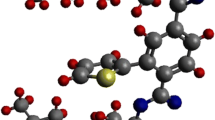Abstract
The absorption and fluorescence of substituted distyrylbenzene (DSB) derivatives and segmented poly(phenylene vinylene) (PPV) derivatives are characterized by long-wavelength absorption maxima and absorption coefficients of λa = 380–450 nm, ε = 20,000–60,000 M−1 cm1 and fluorescence maxima, quantum yields, and decay times of λr = 440–530 nm, Φf = 0.2–0.9, and Τ = 0.8–2.5 ns, respectively. Alkoxy substituents at the central phenylene ring of DSB groups increase the bathochromic shift in the spectra in comparison to DSB, without a significant decrease in the high DSB fluorescence quantum yield. Both phenyl and cyano substitutions at the vinylene bridge lead to a further bathochromic shift of the fluorescence and a decrease in the quantum yield to ca. 0.4. The DSB derivatives and the related segmented PPV derivatives show nearly the same absorption spectra, fluorescence spectra, and radiative rate constantsk f= Φf/Τ, indicating the efficacy of the segmentation of the polymer chain. The radiative rate constants determined by the Φf and Τ values and by the Strickler/Berg formula are in reasonable agreement. This supports the possibility of interpreting the properties of the polymers in terms of their DSB units. The decrease in the emission anisotropy can be ascribed to multistep energy transfer processes between different oriented segments.
Similar content being viewed by others
References
J. H. Burroughes, D. D. C. Bradley, A. R. Brown, R. N. Marks, K. MacKay, R. H. Friend, P. L. Burn, and A. B. Holmes (1990)Nature 347, 539. D. Brown and A. J. Heeger (1991)Appl. Phys. Lett. 58, 1982. J. R. Sheats, H. Antoniadis, M. Hueschen, W. Leonard, J. Miller, R. Moon, D. Roitman, and A. Stocking (1996)Science 273, 884.
D. Moses (1992)Appl. Phys. Lett. 60, 12215. F. Hide, B. Schwartz, M. A. Diaz-Garcia, and A. J. Heeger (1996)Chem. Phys. Lett. 256, 424.
H. Rost, S. Pfeiffer, A. Teuschel, and H.-H. and Hörhold (1997)Synth. Metals 84, 269.
H.-H. Hörhold, H. Rost, A. Teuschel, W. Kreuder, and H. Spreitzer (1998)Proc. SPIE 3148, in press.
W. Kreuder, D. Lupo, J. Salbeck, H. Schenk, T. Stehlin, H.-H. Hörhold, A. Lux, A. Teuschel, and M. Wieduwilt (1996) WO 96/10617, Hoechst AG.
W. Kreuder, H.-H. Hörhold, and H. Rost (1997) DE 19532574A1 (OS 6.3.1997), Hoechst AG.
K. Sandros, M. Sundahl, O. Wennerström, and U. Norinder (1990)J. Am. Chem. Soc. 112, 3082–3086.
U. Mazzucato and F. Momicchioli (1991)Chem. Rev. 91, 1679–1719.
R. Erckel and H. Frühbeis (1982)Z. Naturforsch 37b, 1472–1480.
K. Gustav and A. Geyer (1992)J. Prakt. Chem. 334, 505–508.
S. J. Strickler and R. A. Berg (1962)J. Chem. Phys. 37, 814.
Th. Förster (1948)Ann. Phys. 2, 55.
G. Drefahl, R. Kühmstedt, H. Oswald, and H.-H. Hörhold (1970)Makromol. Chem. 131, 89
H. Rost, H.-H. Hörhold, W. Kreuder, and H. Spreitzer (1998)Proc. SPIE 3148, in press
H. Tillmann and H.-H. Hörhold (1997) Poster presented at PAT ’97, Polymers for Advanced Technology, Leipzig, Germany, Sept.
Author information
Authors and Affiliations
Rights and permissions
About this article
Cite this article
Birckner, E., Grummt, UW., Rost, H. et al. Fluorescence spectroscopy of potential electroluminescent materials: Substituent effects on DSB and segmented PPV derivatives. J Fluoresc 8, 73–80 (1998). https://doi.org/10.1007/BF02758240
Received:
Accepted:
Issue Date:
DOI: https://doi.org/10.1007/BF02758240




